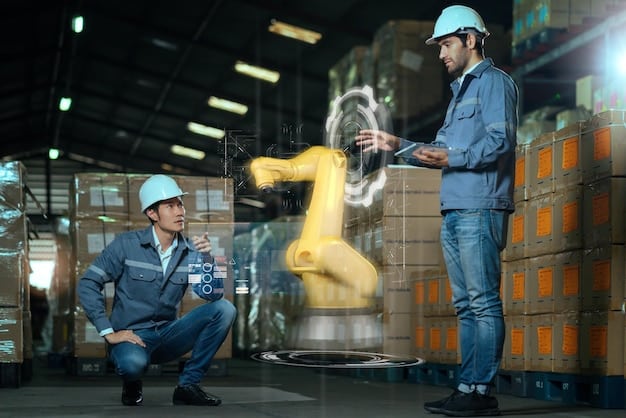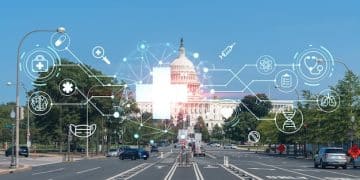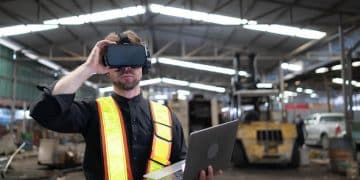Robotics and US Manufacturing: Jobs in 2030

The future of robotics will profoundly reshape US manufacturing jobs by 2030, automating repetitive tasks while simultaneously creating demand for new, higher-skilled roles in robot maintenance, programming, and data analysis.
The landscape of manufacturing in the United States stands on the cusp of a profound transformation, driven largely by rapid advancements in robotics and automation. When we consider The Future of Robotics: How Will Automation Impact Manufacturing Jobs in the US by 2030?, we delve into a complex interplay of innovation, workforce adaptation, and economic evolution. This isn’t merely about machines replacing humans; it’s about a fundamental redefinition of roles, skills, and industry structures.
The Automation Imperative: Why Robotics is Reshaping US Manufacturing
The drive towards automation in US manufacturing is not arbitrary; it’s a strategic response to several economic and operational pressures. Global competition, rising labor costs, and the desire for higher quality and efficiency are compelling manufacturers to integrate robotics at an unprecedented pace. This integration isn’t just about reducing headcount; it’s about achieving levels of precision, speed, and consistency that human labor simply cannot match, especially in repetitive and dangerous tasks.
Manufacturers are increasingly realizing that advanced robotics offers a pathway to reshoring production and maintaining competitiveness on a global scale. Automation makes domestic production more viable by offsetting high labor costs, reducing lead times, and enhancing supply chain resilience. This shift is less about eliminating jobs and more about redefining how value is created in the manufacturing process.
Drivers of Robotic Adoption
Several key factors are accelerating the adoption of robotics in US manufacturing. Understanding these drivers is crucial to appreciating the scale and speed of the upcoming transformation. These elements collectively paint a picture of an industry in flux, adapting to new realities.
- Cost Efficiency: Robots can operate 24/7 with minimal supervision, leading to lower per-unit production costs over time compared to human labor which requires breaks, benefits, and higher wages in the long run. This long-term saving makes automation a compelling investment.
- Enhanced Quality and Precision: Robotic systems perform tasks with extreme accuracy and repeatability, drastically reducing errors and defects. This consistency is vital for advanced manufacturing where tolerances are tight and quality control is paramount.
- Improved Safety: Robots can handle tasks in hazardous environments, such as those involving heavy lifting, extreme temperatures, or exposure to toxic chemicals. This protects human workers from dangerous conditions and reduces workplace injuries.
- Increased Production Speed and Throughput: Automation significantly accelerates production cycles, allowing manufacturers to meet higher demand and bring products to market faster. This leads to increased output and greater profitability.
Beyond these primary drivers, the continuous evolution of robotic hardware and software, coupled with their increasing affordability and ease of integration, further fuels their adoption. What was once only feasible for large corporations is now accessible to small and medium-sized enterprises (SMEs).
The imperative to automate reflects a deeper structural shift within the US economy. It’s about building a more resilient, competitive, and technologically advanced industrial base. While concerns about job displacement are valid, the underlying motivation is often survival and growth in an increasingly demanding global marketplace.
Beyond Displacement: The Creation of New Job Categories
While the initial reaction to discussions about automation often centers on job displacement, a more nuanced perspective reveals significant potential for job creation. As robots increasingly handle repetitive and physically demanding tasks, a new ecosystem of roles is emerging, demanding skills that complement robotic capabilities rather than compete with them. This shift is not just about upskilling existing workers; it’s about fundamentally rethinking the job roles within a modernized factory.

The manufacturing floor of 2030 will likely be populated by technicians, engineers, and data scientists working alongside robotic systems. These new roles require a blend of technical expertise, critical thinking, and problem-solving abilities. The demand for these skills will necessitate significant investment in education and training, both at the academic level and within industries themselves.
Emerging Roles in the Automated Factory
The rise of automation isn’t just eliminating some traditional jobs; it’s giving birth to entirely new job categories that were unimaginable a few decades ago. These roles are critical for the successful deployment, maintenance, and optimization of robotic systems:
- Robotics Technicians & Engineers: These professionals will be responsible for the installation, maintenance, troubleshooting, and repair of robotic systems. They need expertise in mechanics, electronics, software, and sometimes even hydraulics.
- Data Analysts & AI Specialists: Automated factories generate vast amounts of data. Analysts will interpret this data to optimize production processes, predict maintenance needs, and identify inefficiencies. AI specialists will develop and refine the algorithms that drive robotic intelligence.
- Human-Robot Collaboration (Cobot) Operators: As collaborative robots (cobots) become more prevalent, specific roles will emerge for workers who can effectively program, supervise, and work in close proximity with these machines, ensuring seamless human-robot interaction.
- Automation Project Managers: Individuals skilled in overseeing the integration of new robotic systems, ensuring projects are completed on time and within budget, and managing cross-functional teams involved in automation initiatives.
These roles often require a different educational background than traditional manufacturing jobs, emphasizing STEM fields, vocational training in robotics, and continuous learning. Universities and technical colleges are already beginning to adapt their curricula to meet these evolving demands, but the pace of change will need to accelerate.
Furthermore, the increased complexity of automated systems also generates demand for roles in cybersecurity, ensuring that interconnected industrial systems are protected from threats. Quality control will also shift, focusing more on interpreting data from sensor-driven systems rather than manual inspections. The future factory will be a highly technical environment, requiring a highly skilled workforce.
Skills Gap and Workforce Retraining: A National Imperative
One of the most critical challenges associated with the advent of advanced robotics in US manufacturing is the existing skills gap. The current workforce often lacks the specialized knowledge and aptitudes required for the new roles emerging from automation. Addressing this gap is not just an industry concern; it’s a national imperative that requires concerted effort from governments, educational institutions, and businesses.
Without significant investment in workforce retraining and upskilling initiatives, the promise of automation could be hampered by a shortage of qualified personnel. This could lead to a paradox where advanced technology is available, but the human capital needed to deploy and manage it is scarce. The focus must shift from a fear of job loss to an embrace of job evolution, recognizing that continuous learning will be the new norm.
Strategies for Bridging the Skills Gap
Successfully navigating the transition to an automated manufacturing landscape hinges on proactive and comprehensive strategies for workforce development. These approaches must be multi-faceted, involving collaboration between various stakeholders:
- Industry-Academia Partnerships: Collaborations between manufacturing companies and universities/technical colleges can ensure that curricula align with industry needs, providing students with relevant skills and practical experience through internships and apprenticeships.
- Government-Funded Retraining Programs: Publicly funded initiatives can provide accessible and affordable training for displaced workers or those needing to upskill. These programs can focus on certifications in robotics, mechatronics, data analytics, and programming.
- Company-Led Upskilling Initiatives: Manufacturers themselves have a vested interest in training their existing workforce. Internal training programs, often supported by technology vendors, can help employees transition to new roles within the same company.
- Modular and Micro-Credentialing Courses: Offering shorter, specialized courses that lead to micro-credentials can make learning more flexible and targeted, allowing individuals to acquire specific skills quickly without committing to long degree programs.
The emphasis should be on flexible learning pathways that cater to diverse needs, from entry-level workers to experienced professionals. This includes online learning platforms, blended learning models, and on-the-job training. Apprenticeships, in particular, offer a promising model for hands-on, paid training that directly addresses industry demands.
Furthermore, fostering a culture of lifelong learning is essential. As technology continues to evolve, the need for new skills will be constant. Encouraging adaptability and continuous professional development will be key to ensuring a resilient and future-ready US manufacturing workforce.
Economic Shifts: Productivity, Competitiveness, and Wages
The widespread adoption of robotics in US manufacturing will not only influence job roles but also trigger significant economic shifts. These changes encompass enhanced productivity, increased global competitiveness for US firms, and a likely redistribution of wages and income within the manufacturing sector. These are complex interdependencies, and the overall economic outcome will depend heavily on policy decisions and industry responses.
Increased productivity, by definition, means more output with the same or fewer inputs, leading to higher efficiency and potentially lower costs for consumers. For US manufacturers, this translates into a stronger position in the global marketplace, potentially attracting more investment and enabling them to compete more effectively against countries with lower labor costs. However, the benefits of this increased wealth must be broadly distributed to avoid exacerbating economic inequality. The long-term impact on wages is particularly nuanced, as some roles may see declines while others — particularly skilled positions — could experience significant growth.
The Economic Ripple Effect of Automation
The economic ramifications of automation extend far beyond the factory floor, creating a ripple effect throughout the economy. Understanding these broader impacts is essential for effective policy planning:
- Boosted Productivity: Robots can work continuously and with high precision, dramatically increasing output per worker hour. This boost in productivity can drive economic growth and enhance a nation’s overall wealth.
- Enhanced Global Competitiveness: By offsetting higher labor costs, automation allows US manufacturers to produce goods competitively on home soil, potentially leading to reshoring of supply chains and reduced reliance on overseas production.
- Potential for Wage Polarization: While highly skilled roles in robotics and data may command higher wages, jobs involving routine tasks that are easily automated might see downward pressure on wages or even displacement. This could contribute to wage polarization unless proactive measures are taken.
- New Industries and Start-ups: The robotics revolution itself creates entirely new industries focused on robot manufacturing, maintenance, software development, and systems integration. This fosters innovation and creates new entrepreneurial opportunities.
Policymakers will face the challenge of maximizing the economic benefits of automation while mitigating its potential downsides. This includes exploring policies such as universal basic income, robust social safety nets, and tax incentives for companies that invest in workforce training. The goal should be to ensure that the gains from automation are shared across society, fostering inclusive growth rather than concentrating wealth at the top.
Ultimately, the economic impact of automation is not predestined; it will be shaped by how society chooses to adapt. Investing in human capital, fostering innovation, and designing equitable economic policies will be crucial in leveraging automation for widespread prosperity in the US.
Policy and Education: Shaping the Future Workforce
As the impact of robotics on manufacturing jobs becomes increasingly clear, the roles of government policy and educational institutions become paramount. Proactive and forward-thinking strategies are essential to ensure the US workforce is prepared for the inevitable changes and that the economic benefits of automation are widely shared. This involves a collaborative effort to anticipate future needs and develop comprehensive solutions.

Policy frameworks need to evolve beyond traditional labor laws to encompass the nuances of an automated economy. Similarly, educational systems—from K-12 to higher education and vocational training—must adapt to teach the skills that will be in demand. The success of this transition hinges on a unified vision among various stakeholders, including industry leaders, labor unions, and non-profit organizations.
Key Areas for Policy and Educational Intervention
To effectively manage the transition, governments and educational systems must focus on several critical areas. These interventions will lay the groundwork for a resilient and adaptable workforce:
- Modernizing Education Curricula: Integrating AI, robotics, data science, and advanced manufacturing principles into K-12, vocational, and university programs is crucial. Emphasis should be placed on STEM fields, critical thinking, problem-solving, and adaptability.
- Funding for Retraining and Skill Development: Governments can provide grants and incentives for companies to invest in employee retraining. Publicly funded centers for advanced manufacturing skills can offer accessible training pathways for the workforce.
- Developing New Labor Policies: Policies may need to adapt to address issues like gig economy work in automation, worker protections in human-robot collaboration settings, and potentially new forms of social safety nets for those whose jobs are fully automated.
- Promoting Lifelong Learning: Creating accessible pathways and incentives for continuous learning throughout an individual’s career is vital. This includes micro-credentials, online courses, and employer-sponsored training.
Furthermore, policies encouraging research and development in ethical AI and human-robot interaction are important to ensure that technological advancements align with societal values. Addressing potential legal and ethical challenges posed by increased automation will also be a key policy area.
Governments can also play a role in fostering public-private partnerships that directly address skills gaps. By bringing together industry, academia, and labor, targeted solutions can be developed that are responsive to real-world needs. The goal is not just to react to change but to actively shape a future where technology serves human potential.
Case Studies and Projections: What the Data Suggests
Understanding the impact of automation on manufacturing jobs by 2030 requires moving beyond theoretical discussions and examining real-world case studies and robust data projections. While the future is never entirely predictable, existing trends and analytical models offer valuable insights into what the coming years might hold for the US manufacturing workforce. These studies often highlight the dual nature of automation: both job transformation and job creation.
Various economic models, including those from organizations like the World Economic Forum and the consulting firm McKinsey & Company, consistently show a decline in some manual and administrative roles within manufacturing, offset by a rise in positions requiring advanced technical skills. The key takeaway from these projections is not mass unemployment, but rather a significant shift in the types of jobs available and the skills required for them. Industries that have already heavily invested in automation provide valuable blueprints for how this transition can unfold.
Empirical Evidence and Forecasts
Looking at specific examples and statistical forecasts provides a clearer picture of the evolving job landscape:
- Automotive Industry Transformation: The automotive sector has been a pioneer in robotics adoption. While assembly line jobs have changed, new roles in robotics maintenance, automated welding, and quality control systems have emerged. This industry demonstrates that high levels of automation don’t necessarily equate to zero jobs, but rather different jobs.
- McKinsey Global Institute Projections: Studies by McKinsey suggest that while millions of jobs worldwide are susceptible to automation, a similar number of new jobs will likely be created, often in higher-skilled categories. For the US, this implies a need for significant reskilling.
- Warehouse Automation and Logistics: The rise of automation in warehouses (e.g., Amazon’s fulfillment centers) shows a shift from manual sorting and picking to roles in operating and maintaining complex robotic systems, data analysis for logistics optimization, and overseeing automated guided vehicles (AGVs).
- Advanced Manufacturing Hubs: Regions in the US investing heavily in advanced manufacturing clusters are seeing growth in roles like mechatronics technicians, industrial control systems engineers, and predictive maintenance specialists, indicating a shift towards high-tech manufacturing employment.
These case studies underscore the importance of adaptability within the workforce and robust training infrastructure. Companies that have successfully integrated automation often highlight that the challenge is less about finding “new” workers and more about training their existing employees to operate and manage the new systems.
Furthermore, the data suggests that small and medium-sized enterprises (SMEs) will gradually increase their adoption of robotics, requiring tailored support programs to help them implement these technologies and manage the associated workforce transitions. The projections are not static; they are dynamic, influenced by ongoing technological innovation, economic conditions, and policy interventions.
Ethical Considerations and the Human Element
Beyond the economic and technological shifts, the future of robotics in manufacturing also raises profound ethical questions and necessitates a deeper consideration of the human element. Automation’s impact extends beyond mere job numbers; it touches on issues of societal equity, worker dignity, and the very nature of human labor. Addressing these concerns proactively is crucial for a just and sustainable transition to an automated future.
While efficiency and productivity are important, neglecting the social and ethical dimensions of automation can lead to significant societal friction. Questions arise about who benefits from increased automation, how to support those whose jobs are displaced, and the psychological impact of working alongside increasingly intelligent machines. A truly forward-thinking approach must integrate these human-centric considerations into policy and industry strategy.
Navigating the Ethical Landscape
The ethical considerations surrounding robotics in manufacturing are multifaceted and require careful deliberation. Ignoring them would be to invite future social and economic challenges:
- Ensuring Fair Distribution of Gains: How can the increased wealth and productivity generated by automation be equitably distributed across society, preventing further wealth concentration and income inequality? This involves discussions about corporate responsibility and taxation policies.
- Supporting Displaced Workers: Beyond retraining, what social safety nets and support mechanisms are necessary for individuals whose jobs are made obsolete? This could involve unemployment benefits, relocation assistance, or income support programs.
- Maintaining Worker Dignity and Purpose: As robots take over repetitive tasks, how do companies ensure that human roles remain meaningful and provide opportunities for growth and contribution? This requires thoughtful job redesign and fostering an inclusive work environment.
- Bias in AI and Robotics: Ensuring that the algorithms driving robotic systems are free from human biases is critical. This impacts hiring, task allocation, and operational decisions, highlighting the need for ethical AI development.
- Data Privacy and Surveillance: Automated factories generate vast amounts of data, including worker performance data. Ethical guidelines are needed to ensure privacy is protected and data is used responsibly and transparently.
The development of “human-in-the-loop” systems, where human oversight and decision-making remain integral, is one approach to address some of these concerns. Collaborative robots (cobots) are designed with this philosophy, allowing humans and robots to work together safely and efficiently, leveraging the strengths of both.
Ultimately, the discussion about robotics in manufacturing jobs by 2030 is not just about technology; it’s about a societal choice. It’s about designing a future where automation enhances human potential and contributes to a more prosperous and equitable society, rather than creating new forms of disenfranchisement. Engaging in open dialogue and prioritizing human well-being will be essential for success.
| Key Aspect | Brief Description |
|---|---|
| 🤖 Job Transformation | Automation will shift jobs from repetitive tasks to roles requiring technical skills, data analysis, and human-robot collaboration. |
| 🎓 Skills Imperative | Significant investment in retraining and upskilling programs is crucial to bridge the growing gap in advanced manufacturing skills. |
| 💰 Economic Impact | Increased productivity and competitiveness for US manufacturing, but careful management needed to address potential wage polarization. |
| 🤝 Ethical Considerations | Addressing equitable wealth distribution, worker dignity, and job creation alongside automation benefits is essential for societal well-being. |
Frequently Asked Questions About Robotics and Manufacturing Jobs
▼
No, robots are unlikely to eliminate all manufacturing jobs by 2030. Instead, automation will transform existing roles, automating repetitive tasks while creating new positions requiring different skills. The shift will be towards jobs focused on robotics maintenance, programming, data analysis, and human-robot collaboration, rather than a complete replacement of the workforce.
▼
Skills in robotics maintenance and repair, programming (especially for industrial robots and AI), data analytics, and mechatronics will be highly sought after. Additionally, soft skills like critical thinking, problem-solving, and adaptability will be crucial, as workers will increasingly manage and optimize complex automated systems rather than performing manual tasks.
▼
The cost of robotics is decreasing, and collaborative robots (cobots) are becoming more affordable and easier to integrate, making automation accessible to SMEs. Government grants, tax incentives, and regional manufacturing assistance programs are also being developed to help smaller manufacturers adopt these technologies, fostering a more competitive domestic industry.
▼
Government will play a crucial role by investing in workforce retraining initiatives, modernizing educational curricula to include STEM and AI skills, and fostering public-private partnerships. Policies might also address social safety nets for displaced workers, and incentivize companies to invest in employee upskilling and ethical AI development.
▼
For skilled roles in robot programming, maintenance, and data analysis, wages are likely to increase due to higher demand and the specialized nature of the work. However, for highly repetitive or less skilled jobs that are easily automated, wage growth might stagnate or decline. The overall impact on aggregate wages will depend on how effectively the workforce adapts and upskills.
Conclusion
The year 2030 is not far off, and the trajectory for US manufacturing is clear: The Future of Robotics: How Will Automation Impact Manufacturing Jobs in the US by 2030? points towards a significant transformation, not an annihilation, of the workforce. While some jobs will undoubtedly be displaced or fundamentally reshaped, the concurrent creation of new, higher-skilled roles presents an immense opportunity. The success of this transition hinges on a proactive and concerted effort from all stakeholders—industry, government, and educational institutions—to invest in reskilling, foster innovation, and ensure an equitable distribution of automation’s benefits. The factories of tomorrow will be characterized by human-robot collaboration, demanding a workforce that is adaptable, tech-savvy, and continuously learning, ultimately leading to a more competitive and advanced US manufacturing sector.





